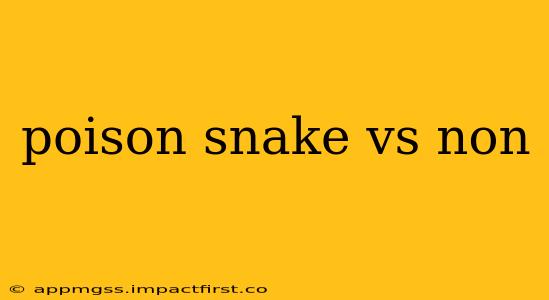Poisonous Snake vs. Non-Poisonous Snake: A Comprehensive Guide
Identifying poisonous snakes is crucial for safety, especially in regions where venomous species are prevalent. This guide will help you understand the key differences between poisonous and non-poisonous snakes, equipping you with knowledge to react appropriately in encounters. While this information is helpful, it's crucial to remember that this should not replace professional identification from a herpetologist or wildlife expert. Never attempt to handle a snake yourself.
What Makes a Snake Poisonous?
The critical distinction lies in the presence and function of venom glands and fangs. Poisonous snakes (also correctly termed venomous snakes) possess specialized glands that produce venom, a complex mixture of toxins. They use modified teeth, called fangs, to inject this venom into their prey or, defensively, into a perceived threat. Non-poisonous snakes lack these specialized glands and fangs, relying instead on constriction or other methods to subdue their prey.
How to Tell the Difference: Visual Clues (Important Note: These are guidelines, not foolproof identifiers!)
Unfortunately, there's no single, universally reliable visual cue to distinguish poisonous from non-poisonous snakes. Many non-venomous snakes mimic the appearance of venomous ones (mimicry) to deter predators. However, some common features are associated with venomous snakes, though exceptions exist:
- Head Shape: Many (but not all!) venomous snakes have triangular-shaped heads, often broader behind the eyes. This is due to the presence of venom glands. However, many non-venomous snakes can also have somewhat triangular heads due to muscle development or other reasons.
- Pupil Shape: Venomous snakes often have elliptical or cat-like pupils, while non-venomous snakes typically have round pupils. Again, this is not a definitive rule.
- Fangs: The presence of visible fangs is a strong indicator of venomousness. However, rear-fanged snakes (which possess smaller fangs in the back of their mouths) can be difficult to identify without handling (which is strongly discouraged!).
- Heat-sensing pits: Some pit vipers (a family of venomous snakes) have heat-sensing pits between their eyes and nostrils, allowing them to detect infrared radiation emitted by warm-blooded prey.
What Are Some Common Venomous Snake Families?
Several families of snakes are known for containing venomous species. These include:
- Viperidae (Vipers): This family includes vipers, rattlesnakes, and pit vipers, characterized by their hinged fangs and often triangular heads.
- Elapidae (Elapids): This family encompasses cobras, kraits, mambas, and coral snakes, known for their fixed, erect fangs.
- Hydrophiidae (Sea Snakes): These are entirely aquatic and highly venomous.
What Are Some Common Non-Venomous Snake Families?
Many snake families are predominantly non-venomous. These include:
- Colubridae (Colubrids): This is the largest snake family and includes a vast majority of non-venomous snakes. Some colubrids do possess mild venom, but it is rarely harmful to humans.
- Boidae (Boas): Boas and pythons are constrictors, using their powerful bodies to suffocate prey.
- Pythonidae (Pythons): Similar to boas, pythons are constrictors.
How Can I Learn to Identify Snakes in My Area?
The best way to learn to identify snakes is through reputable resources specific to your geographic location:
- Field guides: Many excellent field guides are available for specific regions, providing detailed descriptions and photographs of local snake species.
- Local herpetological societies: These organizations often offer workshops, guided walks, and other educational opportunities.
- Reputable online resources: Websites of universities, museums, and conservation organizations can provide reliable information. Always verify information from multiple trusted sources.
What Should I Do If I Encounter a Snake?
Give the snake space! Observe it from a safe distance and do not attempt to handle it. If you are in an area known for venomous snakes, be cautious and aware of your surroundings. If bitten by a snake, seek immediate medical attention. Try to note the snake's appearance (without putting yourself at risk) to help medical professionals administer appropriate treatment.
Disclaimer: This information is for educational purposes only and should not be considered a substitute for professional advice. Always consult with qualified experts for accurate identification and handling of snakes.
